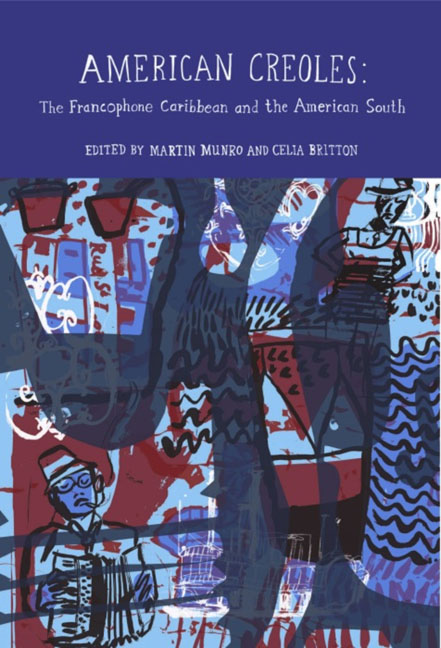Book contents
- Frontmatter
- Contents
- List of Illustrations
- Acknowledgements
- Introduction
- Creolizations
- Lafcadio Hearn's American Writings and the Creole Continuum
- Auguste Lussan's La Famille créole: How Saint-Domingue émigrés Became Louisiana Creoles
- Caribbean and Creole in New Orleans
- Creolizing Barack Obama
- Richard Price or the Canadian from Petite-Anse: The Potential and the Limitations of a Hybrid Anthropology
- Music
- Intertextualities: Faulkner, Glissant, Condé
- Notes on Contributors
- Index
Auguste Lussan's La Famille créole: How Saint-Domingue émigrés Became Louisiana Creoles
from Creolizations
- Frontmatter
- Contents
- List of Illustrations
- Acknowledgements
- Introduction
- Creolizations
- Lafcadio Hearn's American Writings and the Creole Continuum
- Auguste Lussan's La Famille créole: How Saint-Domingue émigrés Became Louisiana Creoles
- Caribbean and Creole in New Orleans
- Creolizing Barack Obama
- Richard Price or the Canadian from Petite-Anse: The Potential and the Limitations of a Hybrid Anthropology
- Music
- Intertextualities: Faulkner, Glissant, Condé
- Notes on Contributors
- Index
Summary
Introduction
The 1791 slave uprising in Saint-Domingue, followed by the revolution and Haiti's independence in 1804, had a profound impact on Louisiana. Soon after the uprising began, hundreds of refugees from the island trickled into New Orleans. Around 1803, thousands more arrived. Six years later, in a few months between 1809 and 1810, 10,000 of them poured into the region when they were no longer welcome in Cuba, where they had first settled after fleeing Saint-Domingue. The sheer number of refugees doubled the population of New Orleans, which reached 25,000 by 1810, turning it into the seventh largest city in the United States; by 1820, it was the fifth largest. The Saint-Domingue refugees’ impact on New Orleans in particular, and on Louisiana as a whole, was not just numerical. Within a few decades, they transformed the city into a cultural centre: the refugees created the first newspapers, theatres and opera in New Orleans. Economically, although most refugees were impoverished when they arrived in Louisiana, many became part of a successful middle class as merchants, teachers, journalists, actors, politicians, lawyers and doctors. Politically, they added to the controversies surrounding Louisiana's loyalty to the American government by boosting the number of French speakers, and they reinforced the three-tiered racial system that troubled Americans, who were accustomed to a binary racial organization.
By the late 1830s, at the time of Auguste Lussan's play La Famille créole [The Creole Family] (1837), Louisianians’ collective memory of this important community was already beginning to fade as the death of older refugees and exogamy dissolved the community (although not its culture) within the larger Creole society of the region (Dessens, 2007: 61–62). Lussan's play acts as a reminder of the centrality of the Saint-Domingue refugees to Louisiana's identity by telling the story of the Clairville family, former planters from Saint-Domingue. But it does so in a way that carefully Americanizes both Louisiana and its Creole refugees. Typical of the genre of the melodrama to which it belongs, it offered entertainment with a conservative ideology that was reassuring for the public during chaotic times (Przybos, 1984: 308).
- Type
- Chapter
- Information
- American CreolesThe Francophone Caribbean and the American South, pp. 40 - 55Publisher: Liverpool University PressPrint publication year: 2012

